Critical Evaluation of Drug and Alcohol Abuse Research, Semester 1
VerifiedAdded on 2023/04/23
|10
|2689
|165
Report
AI Summary
This report provides a critical evaluation of three academic research studies focusing on drug and alcohol abuse. The first study examines the effectiveness of a structured Naltrexone treatment program, comparing experimental and control groups with various outcome measures. The second article investigates anger-control group counseling for women recovering from alcohol or drug addiction, analyzing the impact of cognitive-behavioral therapy. The third study explores the efficacy of buprenorphine treatment for prisoners before and after release, assessing its effects on both genders. The report analyzes the methodologies, findings, limitations, and implications of each study, providing a comparative analysis and considering their relevance to AOD counseling practice. The research uses quantitative methods, including randomized control trials and statistical analysis, to assess the effectiveness of different interventions. The report also notes the limitations of each study, such as sample size, participant adherence, and the lack of control groups. Overall, the report offers insights into the complexities of drug and alcohol abuse research and its impact on treatment approaches.
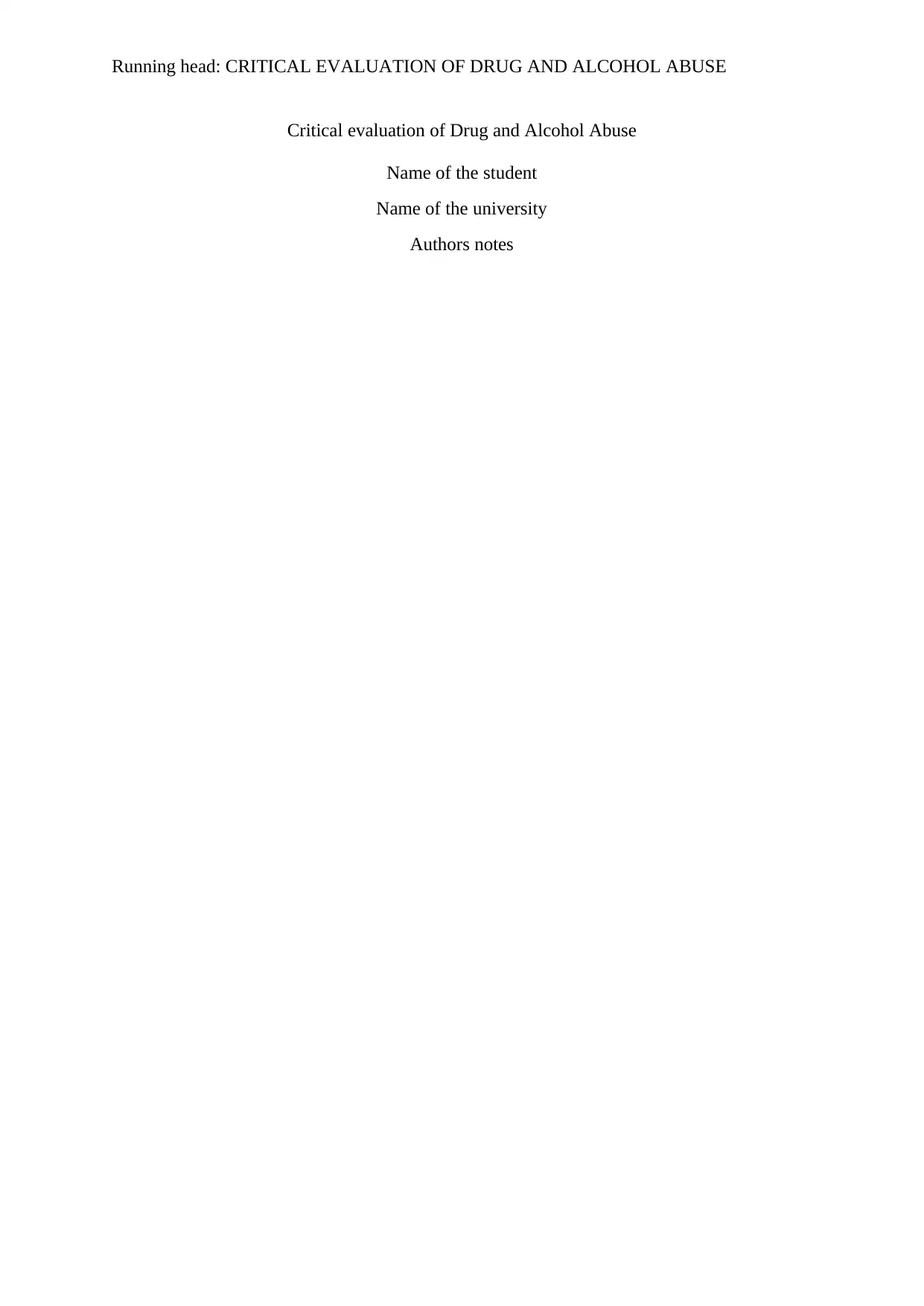
Running head: CRITICAL EVALUATION OF DRUG AND ALCOHOL ABUSE
Critical evaluation of Drug and Alcohol Abuse
Name of the student
Name of the university
Authors notes
Critical evaluation of Drug and Alcohol Abuse
Name of the student
Name of the university
Authors notes
Paraphrase This Document
Need a fresh take? Get an instant paraphrase of this document with our AI Paraphraser
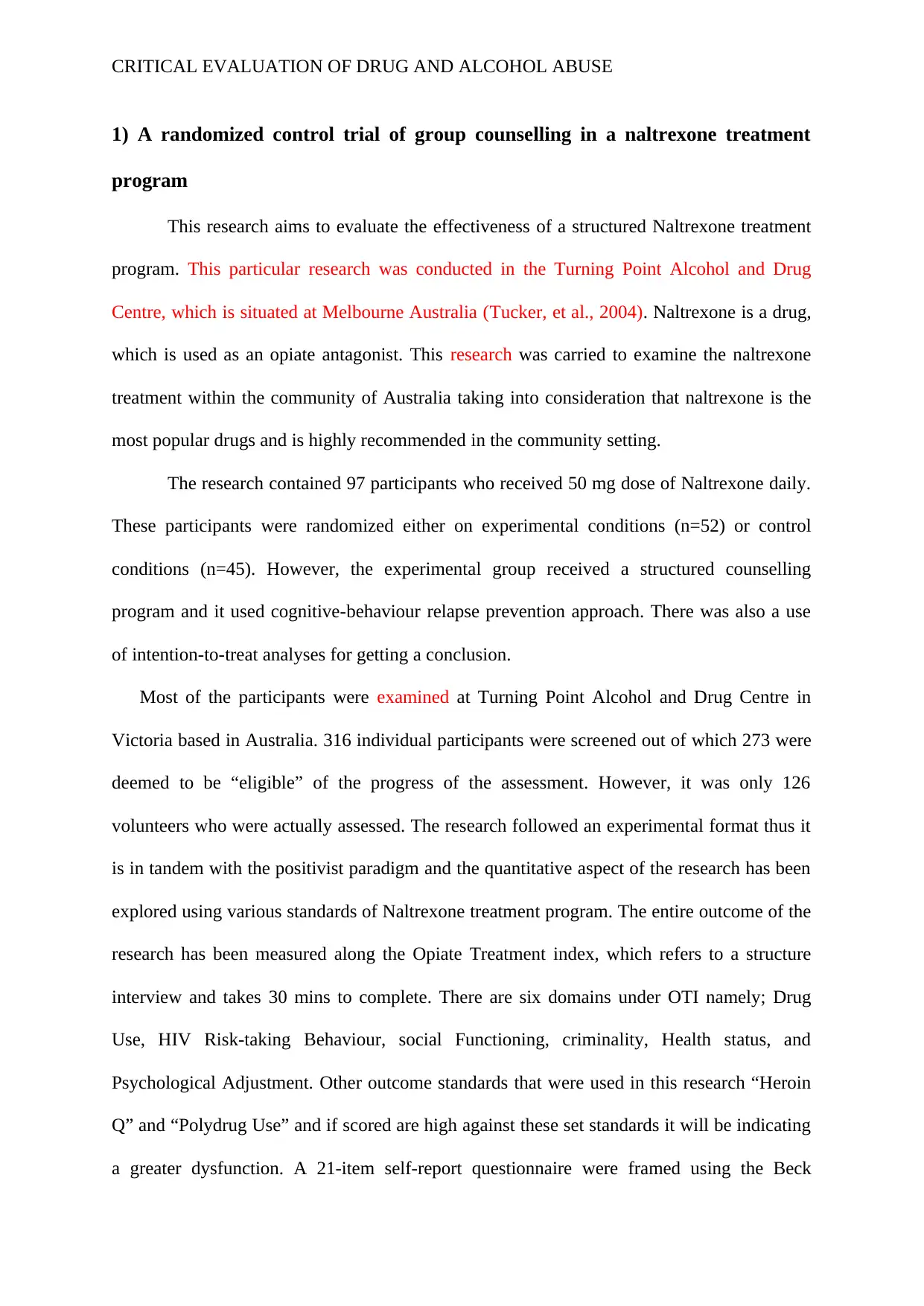
CRITICAL EVALUATION OF DRUG AND ALCOHOL ABUSE
1) A randomized control trial of group counselling in a naltrexone treatment
program
This research aims to evaluate the effectiveness of a structured Naltrexone treatment
program. This particular research was conducted in the Turning Point Alcohol and Drug
Centre, which is situated at Melbourne Australia (Tucker, et al., 2004). Naltrexone is a drug,
which is used as an opiate antagonist. This research was carried to examine the naltrexone
treatment within the community of Australia taking into consideration that naltrexone is the
most popular drugs and is highly recommended in the community setting.
The research contained 97 participants who received 50 mg dose of Naltrexone daily.
These participants were randomized either on experimental conditions (n=52) or control
conditions (n=45). However, the experimental group received a structured counselling
program and it used cognitive-behaviour relapse prevention approach. There was also a use
of intention-to-treat analyses for getting a conclusion.
Most of the participants were examined at Turning Point Alcohol and Drug Centre in
Victoria based in Australia. 316 individual participants were screened out of which 273 were
deemed to be “eligible” of the progress of the assessment. However, it was only 126
volunteers who were actually assessed. The research followed an experimental format thus it
is in tandem with the positivist paradigm and the quantitative aspect of the research has been
explored using various standards of Naltrexone treatment program. The entire outcome of the
research has been measured along the Opiate Treatment index, which refers to a structure
interview and takes 30 mins to complete. There are six domains under OTI namely; Drug
Use, HIV Risk-taking Behaviour, social Functioning, criminality, Health status, and
Psychological Adjustment. Other outcome standards that were used in this research “Heroin
Q” and “Polydrug Use” and if scored are high against these set standards it will be indicating
a greater dysfunction. A 21-item self-report questionnaire were framed using the Beck
1) A randomized control trial of group counselling in a naltrexone treatment
program
This research aims to evaluate the effectiveness of a structured Naltrexone treatment
program. This particular research was conducted in the Turning Point Alcohol and Drug
Centre, which is situated at Melbourne Australia (Tucker, et al., 2004). Naltrexone is a drug,
which is used as an opiate antagonist. This research was carried to examine the naltrexone
treatment within the community of Australia taking into consideration that naltrexone is the
most popular drugs and is highly recommended in the community setting.
The research contained 97 participants who received 50 mg dose of Naltrexone daily.
These participants were randomized either on experimental conditions (n=52) or control
conditions (n=45). However, the experimental group received a structured counselling
program and it used cognitive-behaviour relapse prevention approach. There was also a use
of intention-to-treat analyses for getting a conclusion.
Most of the participants were examined at Turning Point Alcohol and Drug Centre in
Victoria based in Australia. 316 individual participants were screened out of which 273 were
deemed to be “eligible” of the progress of the assessment. However, it was only 126
volunteers who were actually assessed. The research followed an experimental format thus it
is in tandem with the positivist paradigm and the quantitative aspect of the research has been
explored using various standards of Naltrexone treatment program. The entire outcome of the
research has been measured along the Opiate Treatment index, which refers to a structure
interview and takes 30 mins to complete. There are six domains under OTI namely; Drug
Use, HIV Risk-taking Behaviour, social Functioning, criminality, Health status, and
Psychological Adjustment. Other outcome standards that were used in this research “Heroin
Q” and “Polydrug Use” and if scored are high against these set standards it will be indicating
a greater dysfunction. A 21-item self-report questionnaire were framed using the Beck
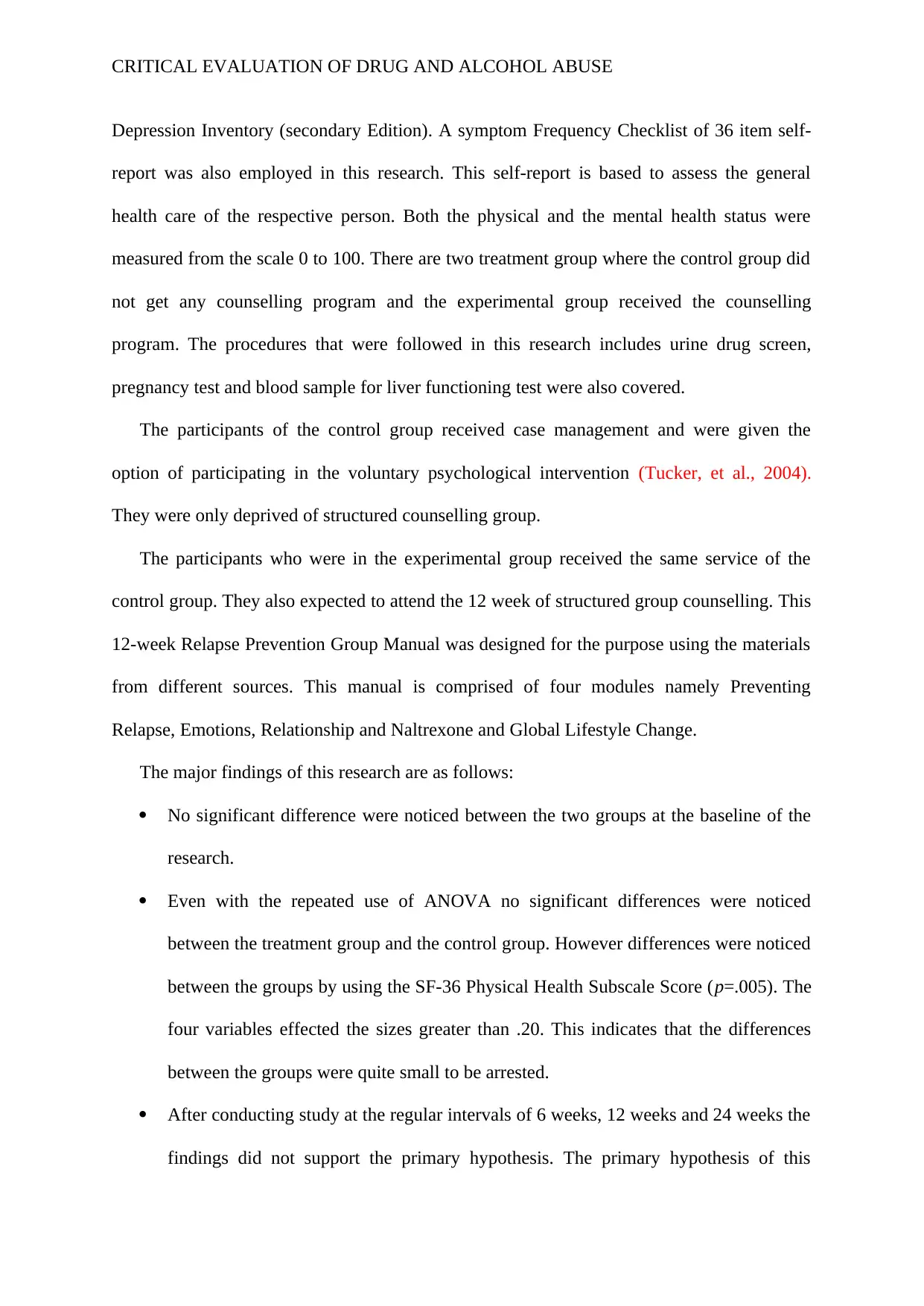
CRITICAL EVALUATION OF DRUG AND ALCOHOL ABUSE
Depression Inventory (secondary Edition). A symptom Frequency Checklist of 36 item self-
report was also employed in this research. This self-report is based to assess the general
health care of the respective person. Both the physical and the mental health status were
measured from the scale 0 to 100. There are two treatment group where the control group did
not get any counselling program and the experimental group received the counselling
program. The procedures that were followed in this research includes urine drug screen,
pregnancy test and blood sample for liver functioning test were also covered.
The participants of the control group received case management and were given the
option of participating in the voluntary psychological intervention (Tucker, et al., 2004).
They were only deprived of structured counselling group.
The participants who were in the experimental group received the same service of the
control group. They also expected to attend the 12 week of structured group counselling. This
12-week Relapse Prevention Group Manual was designed for the purpose using the materials
from different sources. This manual is comprised of four modules namely Preventing
Relapse, Emotions, Relationship and Naltrexone and Global Lifestyle Change.
The major findings of this research are as follows:
No significant difference were noticed between the two groups at the baseline of the
research.
Even with the repeated use of ANOVA no significant differences were noticed
between the treatment group and the control group. However differences were noticed
between the groups by using the SF-36 Physical Health Subscale Score (p=.005). The
four variables effected the sizes greater than .20. This indicates that the differences
between the groups were quite small to be arrested.
After conducting study at the regular intervals of 6 weeks, 12 weeks and 24 weeks the
findings did not support the primary hypothesis. The primary hypothesis of this
Depression Inventory (secondary Edition). A symptom Frequency Checklist of 36 item self-
report was also employed in this research. This self-report is based to assess the general
health care of the respective person. Both the physical and the mental health status were
measured from the scale 0 to 100. There are two treatment group where the control group did
not get any counselling program and the experimental group received the counselling
program. The procedures that were followed in this research includes urine drug screen,
pregnancy test and blood sample for liver functioning test were also covered.
The participants of the control group received case management and were given the
option of participating in the voluntary psychological intervention (Tucker, et al., 2004).
They were only deprived of structured counselling group.
The participants who were in the experimental group received the same service of the
control group. They also expected to attend the 12 week of structured group counselling. This
12-week Relapse Prevention Group Manual was designed for the purpose using the materials
from different sources. This manual is comprised of four modules namely Preventing
Relapse, Emotions, Relationship and Naltrexone and Global Lifestyle Change.
The major findings of this research are as follows:
No significant difference were noticed between the two groups at the baseline of the
research.
Even with the repeated use of ANOVA no significant differences were noticed
between the treatment group and the control group. However differences were noticed
between the groups by using the SF-36 Physical Health Subscale Score (p=.005). The
four variables effected the sizes greater than .20. This indicates that the differences
between the groups were quite small to be arrested.
After conducting study at the regular intervals of 6 weeks, 12 weeks and 24 weeks the
findings did not support the primary hypothesis. The primary hypothesis of this
⊘ This is a preview!⊘
Do you want full access?
Subscribe today to unlock all pages.

Trusted by 1+ million students worldwide
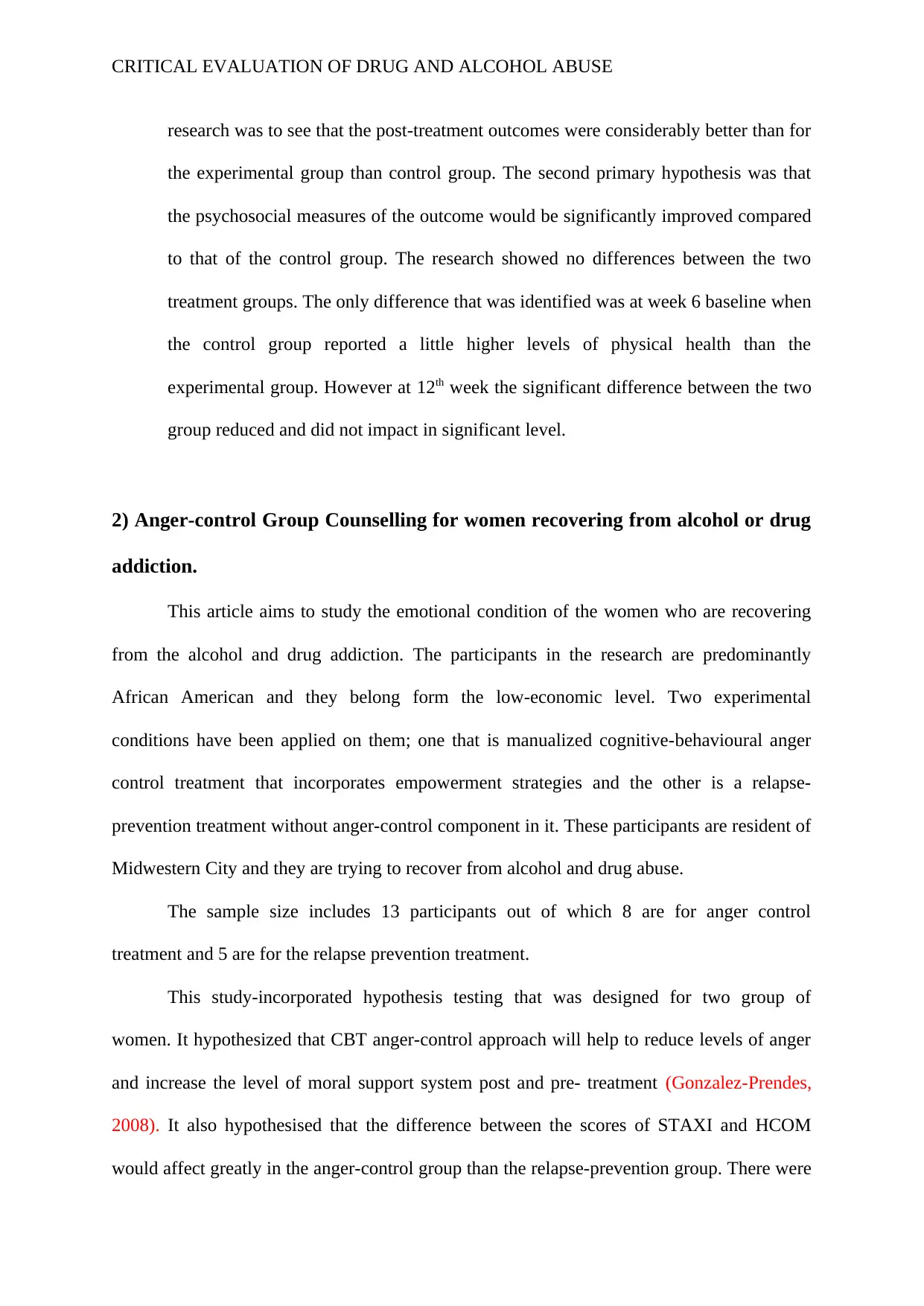
CRITICAL EVALUATION OF DRUG AND ALCOHOL ABUSE
research was to see that the post-treatment outcomes were considerably better than for
the experimental group than control group. The second primary hypothesis was that
the psychosocial measures of the outcome would be significantly improved compared
to that of the control group. The research showed no differences between the two
treatment groups. The only difference that was identified was at week 6 baseline when
the control group reported a little higher levels of physical health than the
experimental group. However at 12th week the significant difference between the two
group reduced and did not impact in significant level.
2) Anger-control Group Counselling for women recovering from alcohol or drug
addiction.
This article aims to study the emotional condition of the women who are recovering
from the alcohol and drug addiction. The participants in the research are predominantly
African American and they belong form the low-economic level. Two experimental
conditions have been applied on them; one that is manualized cognitive-behavioural anger
control treatment that incorporates empowerment strategies and the other is a relapse-
prevention treatment without anger-control component in it. These participants are resident of
Midwestern City and they are trying to recover from alcohol and drug abuse.
The sample size includes 13 participants out of which 8 are for anger control
treatment and 5 are for the relapse prevention treatment.
This study-incorporated hypothesis testing that was designed for two group of
women. It hypothesized that CBT anger-control approach will help to reduce levels of anger
and increase the level of moral support system post and pre- treatment (Gonzalez-Prendes,
2008). It also hypothesised that the difference between the scores of STAXI and HCOM
would affect greatly in the anger-control group than the relapse-prevention group. There were
research was to see that the post-treatment outcomes were considerably better than for
the experimental group than control group. The second primary hypothesis was that
the psychosocial measures of the outcome would be significantly improved compared
to that of the control group. The research showed no differences between the two
treatment groups. The only difference that was identified was at week 6 baseline when
the control group reported a little higher levels of physical health than the
experimental group. However at 12th week the significant difference between the two
group reduced and did not impact in significant level.
2) Anger-control Group Counselling for women recovering from alcohol or drug
addiction.
This article aims to study the emotional condition of the women who are recovering
from the alcohol and drug addiction. The participants in the research are predominantly
African American and they belong form the low-economic level. Two experimental
conditions have been applied on them; one that is manualized cognitive-behavioural anger
control treatment that incorporates empowerment strategies and the other is a relapse-
prevention treatment without anger-control component in it. These participants are resident of
Midwestern City and they are trying to recover from alcohol and drug abuse.
The sample size includes 13 participants out of which 8 are for anger control
treatment and 5 are for the relapse prevention treatment.
This study-incorporated hypothesis testing that was designed for two group of
women. It hypothesized that CBT anger-control approach will help to reduce levels of anger
and increase the level of moral support system post and pre- treatment (Gonzalez-Prendes,
2008). It also hypothesised that the difference between the scores of STAXI and HCOM
would affect greatly in the anger-control group than the relapse-prevention group. There were
Paraphrase This Document
Need a fresh take? Get an instant paraphrase of this document with our AI Paraphraser
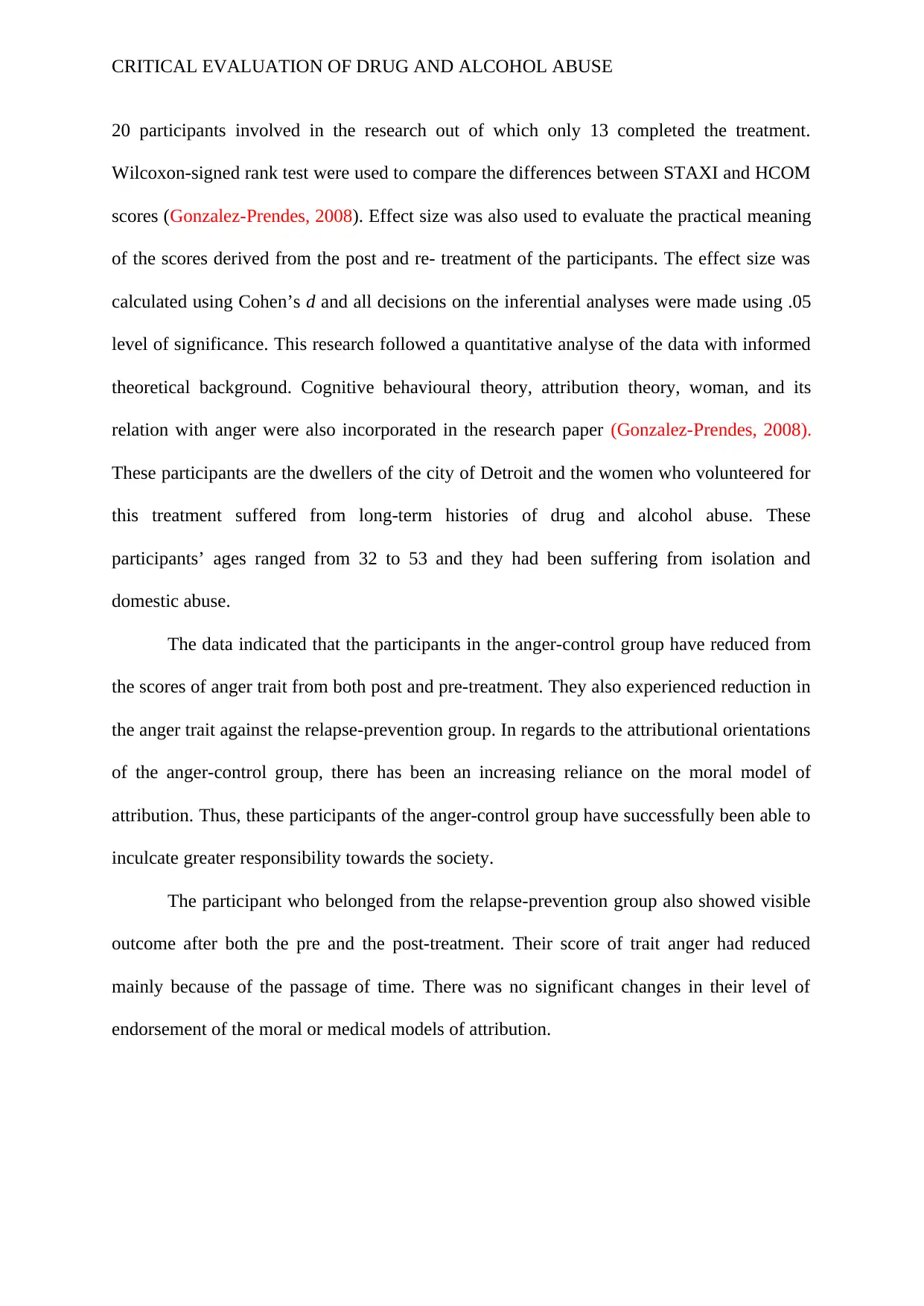
CRITICAL EVALUATION OF DRUG AND ALCOHOL ABUSE
20 participants involved in the research out of which only 13 completed the treatment.
Wilcoxon-signed rank test were used to compare the differences between STAXI and HCOM
scores (Gonzalez-Prendes, 2008). Effect size was also used to evaluate the practical meaning
of the scores derived from the post and re- treatment of the participants. The effect size was
calculated using Cohen’s d and all decisions on the inferential analyses were made using .05
level of significance. This research followed a quantitative analyse of the data with informed
theoretical background. Cognitive behavioural theory, attribution theory, woman, and its
relation with anger were also incorporated in the research paper (Gonzalez-Prendes, 2008).
These participants are the dwellers of the city of Detroit and the women who volunteered for
this treatment suffered from long-term histories of drug and alcohol abuse. These
participants’ ages ranged from 32 to 53 and they had been suffering from isolation and
domestic abuse.
The data indicated that the participants in the anger-control group have reduced from
the scores of anger trait from both post and pre-treatment. They also experienced reduction in
the anger trait against the relapse-prevention group. In regards to the attributional orientations
of the anger-control group, there has been an increasing reliance on the moral model of
attribution. Thus, these participants of the anger-control group have successfully been able to
inculcate greater responsibility towards the society.
The participant who belonged from the relapse-prevention group also showed visible
outcome after both the pre and the post-treatment. Their score of trait anger had reduced
mainly because of the passage of time. There was no significant changes in their level of
endorsement of the moral or medical models of attribution.
20 participants involved in the research out of which only 13 completed the treatment.
Wilcoxon-signed rank test were used to compare the differences between STAXI and HCOM
scores (Gonzalez-Prendes, 2008). Effect size was also used to evaluate the practical meaning
of the scores derived from the post and re- treatment of the participants. The effect size was
calculated using Cohen’s d and all decisions on the inferential analyses were made using .05
level of significance. This research followed a quantitative analyse of the data with informed
theoretical background. Cognitive behavioural theory, attribution theory, woman, and its
relation with anger were also incorporated in the research paper (Gonzalez-Prendes, 2008).
These participants are the dwellers of the city of Detroit and the women who volunteered for
this treatment suffered from long-term histories of drug and alcohol abuse. These
participants’ ages ranged from 32 to 53 and they had been suffering from isolation and
domestic abuse.
The data indicated that the participants in the anger-control group have reduced from
the scores of anger trait from both post and pre-treatment. They also experienced reduction in
the anger trait against the relapse-prevention group. In regards to the attributional orientations
of the anger-control group, there has been an increasing reliance on the moral model of
attribution. Thus, these participants of the anger-control group have successfully been able to
inculcate greater responsibility towards the society.
The participant who belonged from the relapse-prevention group also showed visible
outcome after both the pre and the post-treatment. Their score of trait anger had reduced
mainly because of the passage of time. There was no significant changes in their level of
endorsement of the moral or medical models of attribution.
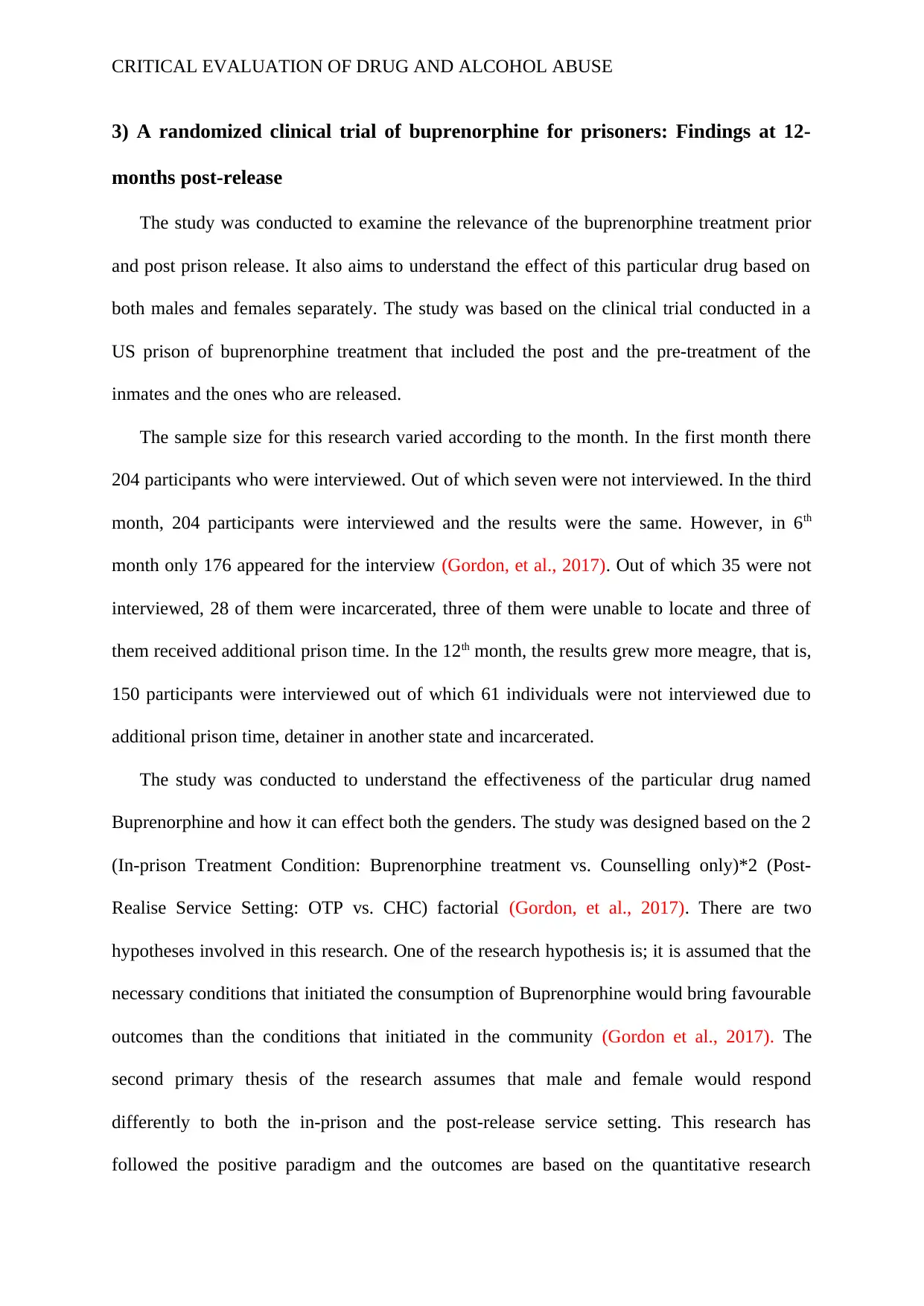
CRITICAL EVALUATION OF DRUG AND ALCOHOL ABUSE
3) A randomized clinical trial of buprenorphine for prisoners: Findings at 12-
months post-release
The study was conducted to examine the relevance of the buprenorphine treatment prior
and post prison release. It also aims to understand the effect of this particular drug based on
both males and females separately. The study was based on the clinical trial conducted in a
US prison of buprenorphine treatment that included the post and the pre-treatment of the
inmates and the ones who are released.
The sample size for this research varied according to the month. In the first month there
204 participants who were interviewed. Out of which seven were not interviewed. In the third
month, 204 participants were interviewed and the results were the same. However, in 6th
month only 176 appeared for the interview (Gordon, et al., 2017). Out of which 35 were not
interviewed, 28 of them were incarcerated, three of them were unable to locate and three of
them received additional prison time. In the 12th month, the results grew more meagre, that is,
150 participants were interviewed out of which 61 individuals were not interviewed due to
additional prison time, detainer in another state and incarcerated.
The study was conducted to understand the effectiveness of the particular drug named
Buprenorphine and how it can effect both the genders. The study was designed based on the 2
(In-prison Treatment Condition: Buprenorphine treatment vs. Counselling only)*2 (Post-
Realise Service Setting: OTP vs. CHC) factorial (Gordon, et al., 2017). There are two
hypotheses involved in this research. One of the research hypothesis is; it is assumed that the
necessary conditions that initiated the consumption of Buprenorphine would bring favourable
outcomes than the conditions that initiated in the community (Gordon et al., 2017). The
second primary thesis of the research assumes that male and female would respond
differently to both the in-prison and the post-release service setting. This research has
followed the positive paradigm and the outcomes are based on the quantitative research
3) A randomized clinical trial of buprenorphine for prisoners: Findings at 12-
months post-release
The study was conducted to examine the relevance of the buprenorphine treatment prior
and post prison release. It also aims to understand the effect of this particular drug based on
both males and females separately. The study was based on the clinical trial conducted in a
US prison of buprenorphine treatment that included the post and the pre-treatment of the
inmates and the ones who are released.
The sample size for this research varied according to the month. In the first month there
204 participants who were interviewed. Out of which seven were not interviewed. In the third
month, 204 participants were interviewed and the results were the same. However, in 6th
month only 176 appeared for the interview (Gordon, et al., 2017). Out of which 35 were not
interviewed, 28 of them were incarcerated, three of them were unable to locate and three of
them received additional prison time. In the 12th month, the results grew more meagre, that is,
150 participants were interviewed out of which 61 individuals were not interviewed due to
additional prison time, detainer in another state and incarcerated.
The study was conducted to understand the effectiveness of the particular drug named
Buprenorphine and how it can effect both the genders. The study was designed based on the 2
(In-prison Treatment Condition: Buprenorphine treatment vs. Counselling only)*2 (Post-
Realise Service Setting: OTP vs. CHC) factorial (Gordon, et al., 2017). There are two
hypotheses involved in this research. One of the research hypothesis is; it is assumed that the
necessary conditions that initiated the consumption of Buprenorphine would bring favourable
outcomes than the conditions that initiated in the community (Gordon et al., 2017). The
second primary thesis of the research assumes that male and female would respond
differently to both the in-prison and the post-release service setting. This research has
followed the positive paradigm and the outcomes are based on the quantitative research
⊘ This is a preview!⊘
Do you want full access?
Subscribe today to unlock all pages.

Trusted by 1+ million students worldwide
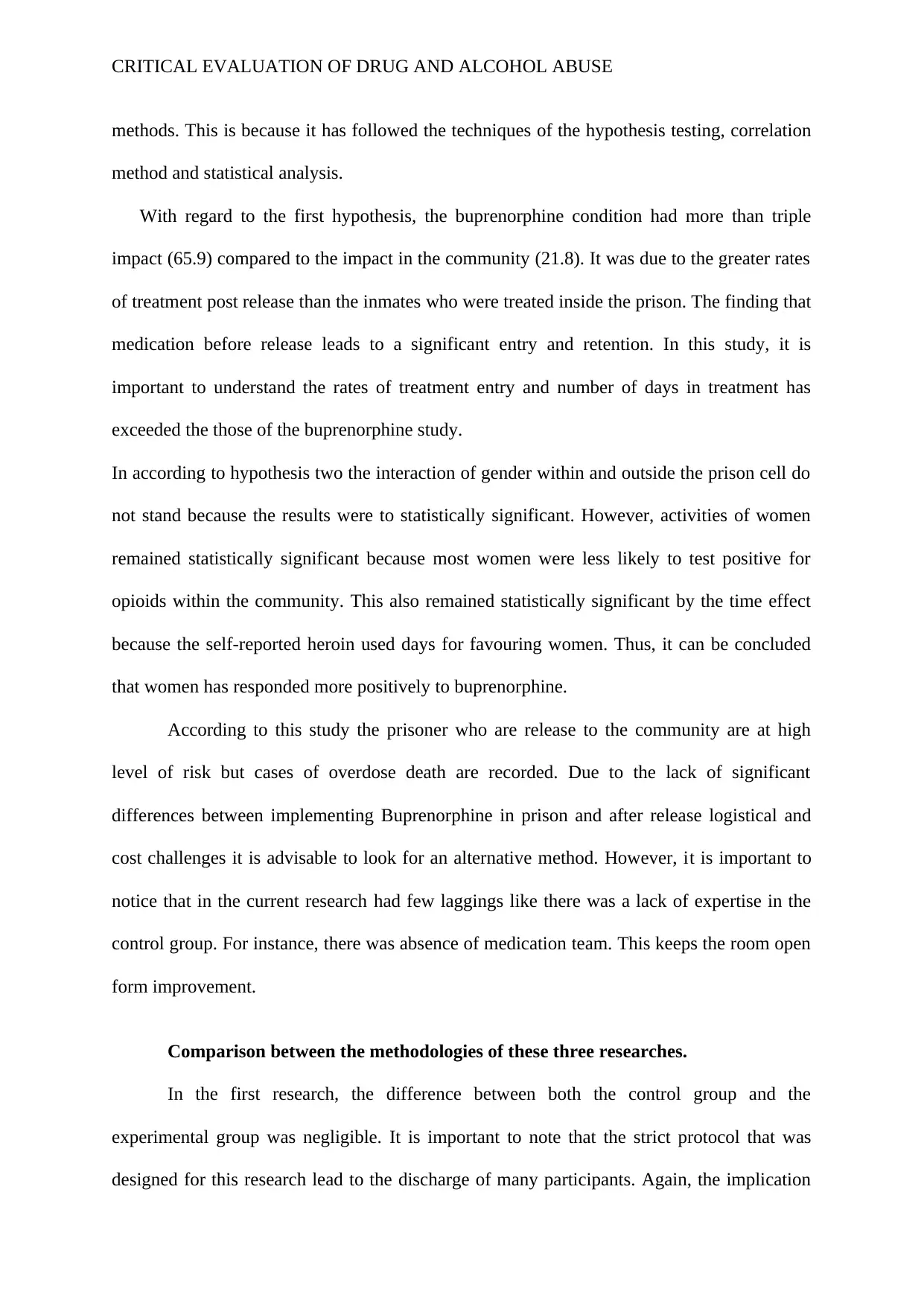
CRITICAL EVALUATION OF DRUG AND ALCOHOL ABUSE
methods. This is because it has followed the techniques of the hypothesis testing, correlation
method and statistical analysis.
With regard to the first hypothesis, the buprenorphine condition had more than triple
impact (65.9) compared to the impact in the community (21.8). It was due to the greater rates
of treatment post release than the inmates who were treated inside the prison. The finding that
medication before release leads to a significant entry and retention. In this study, it is
important to understand the rates of treatment entry and number of days in treatment has
exceeded the those of the buprenorphine study.
In according to hypothesis two the interaction of gender within and outside the prison cell do
not stand because the results were to statistically significant. However, activities of women
remained statistically significant because most women were less likely to test positive for
opioids within the community. This also remained statistically significant by the time effect
because the self-reported heroin used days for favouring women. Thus, it can be concluded
that women has responded more positively to buprenorphine.
According to this study the prisoner who are release to the community are at high
level of risk but cases of overdose death are recorded. Due to the lack of significant
differences between implementing Buprenorphine in prison and after release logistical and
cost challenges it is advisable to look for an alternative method. However, it is important to
notice that in the current research had few laggings like there was a lack of expertise in the
control group. For instance, there was absence of medication team. This keeps the room open
form improvement.
Comparison between the methodologies of these three researches.
In the first research, the difference between both the control group and the
experimental group was negligible. It is important to note that the strict protocol that was
designed for this research lead to the discharge of many participants. Again, the implication
methods. This is because it has followed the techniques of the hypothesis testing, correlation
method and statistical analysis.
With regard to the first hypothesis, the buprenorphine condition had more than triple
impact (65.9) compared to the impact in the community (21.8). It was due to the greater rates
of treatment post release than the inmates who were treated inside the prison. The finding that
medication before release leads to a significant entry and retention. In this study, it is
important to understand the rates of treatment entry and number of days in treatment has
exceeded the those of the buprenorphine study.
In according to hypothesis two the interaction of gender within and outside the prison cell do
not stand because the results were to statistically significant. However, activities of women
remained statistically significant because most women were less likely to test positive for
opioids within the community. This also remained statistically significant by the time effect
because the self-reported heroin used days for favouring women. Thus, it can be concluded
that women has responded more positively to buprenorphine.
According to this study the prisoner who are release to the community are at high
level of risk but cases of overdose death are recorded. Due to the lack of significant
differences between implementing Buprenorphine in prison and after release logistical and
cost challenges it is advisable to look for an alternative method. However, it is important to
notice that in the current research had few laggings like there was a lack of expertise in the
control group. For instance, there was absence of medication team. This keeps the room open
form improvement.
Comparison between the methodologies of these three researches.
In the first research, the difference between both the control group and the
experimental group was negligible. It is important to note that the strict protocol that was
designed for this research lead to the discharge of many participants. Again, the implication
Paraphrase This Document
Need a fresh take? Get an instant paraphrase of this document with our AI Paraphraser
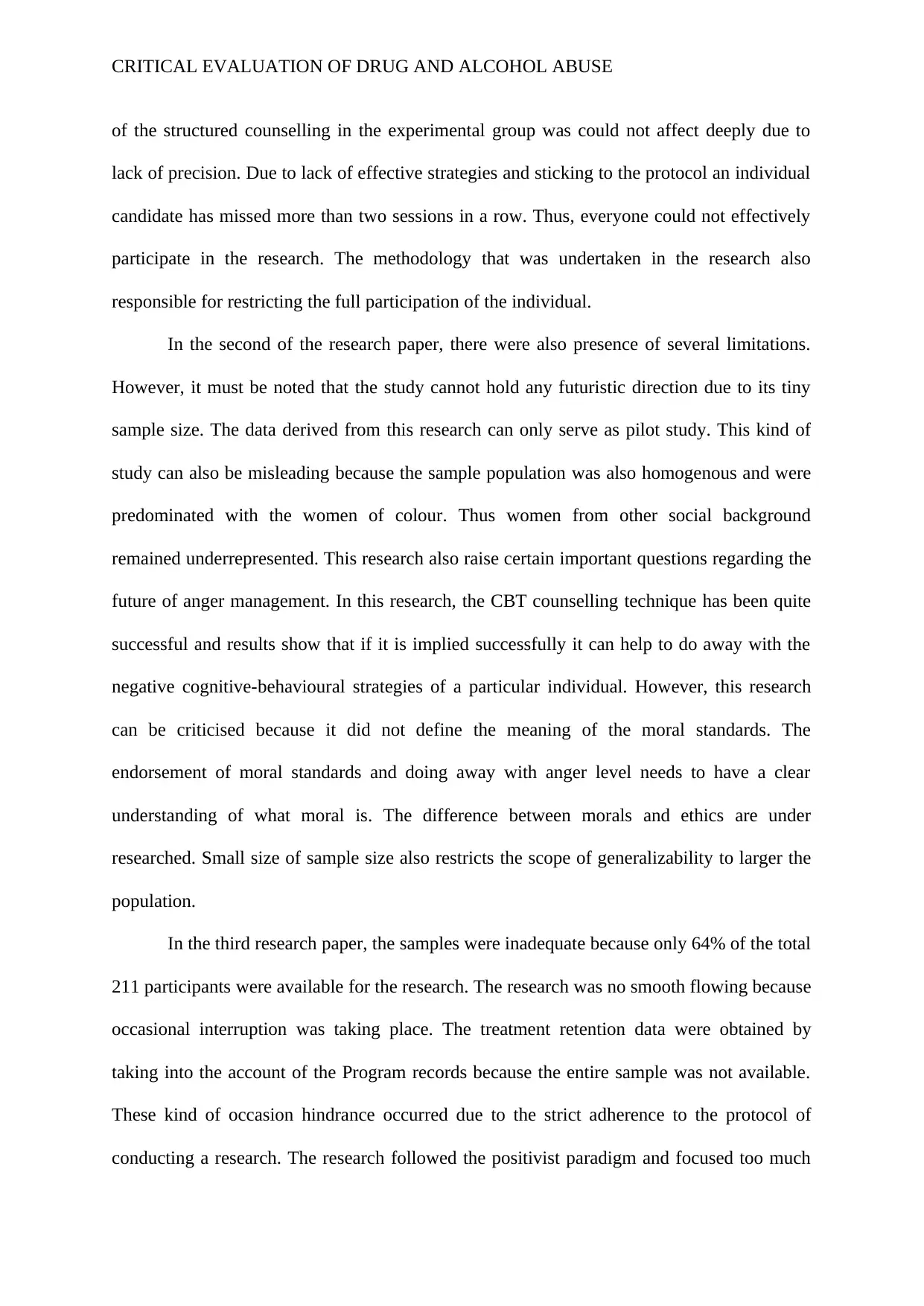
CRITICAL EVALUATION OF DRUG AND ALCOHOL ABUSE
of the structured counselling in the experimental group was could not affect deeply due to
lack of precision. Due to lack of effective strategies and sticking to the protocol an individual
candidate has missed more than two sessions in a row. Thus, everyone could not effectively
participate in the research. The methodology that was undertaken in the research also
responsible for restricting the full participation of the individual.
In the second of the research paper, there were also presence of several limitations.
However, it must be noted that the study cannot hold any futuristic direction due to its tiny
sample size. The data derived from this research can only serve as pilot study. This kind of
study can also be misleading because the sample population was also homogenous and were
predominated with the women of colour. Thus women from other social background
remained underrepresented. This research also raise certain important questions regarding the
future of anger management. In this research, the CBT counselling technique has been quite
successful and results show that if it is implied successfully it can help to do away with the
negative cognitive-behavioural strategies of a particular individual. However, this research
can be criticised because it did not define the meaning of the moral standards. The
endorsement of moral standards and doing away with anger level needs to have a clear
understanding of what moral is. The difference between morals and ethics are under
researched. Small size of sample size also restricts the scope of generalizability to larger the
population.
In the third research paper, the samples were inadequate because only 64% of the total
211 participants were available for the research. The research was no smooth flowing because
occasional interruption was taking place. The treatment retention data were obtained by
taking into the account of the Program records because the entire sample was not available.
These kind of occasion hindrance occurred due to the strict adherence to the protocol of
conducting a research. The research followed the positivist paradigm and focused too much
of the structured counselling in the experimental group was could not affect deeply due to
lack of precision. Due to lack of effective strategies and sticking to the protocol an individual
candidate has missed more than two sessions in a row. Thus, everyone could not effectively
participate in the research. The methodology that was undertaken in the research also
responsible for restricting the full participation of the individual.
In the second of the research paper, there were also presence of several limitations.
However, it must be noted that the study cannot hold any futuristic direction due to its tiny
sample size. The data derived from this research can only serve as pilot study. This kind of
study can also be misleading because the sample population was also homogenous and were
predominated with the women of colour. Thus women from other social background
remained underrepresented. This research also raise certain important questions regarding the
future of anger management. In this research, the CBT counselling technique has been quite
successful and results show that if it is implied successfully it can help to do away with the
negative cognitive-behavioural strategies of a particular individual. However, this research
can be criticised because it did not define the meaning of the moral standards. The
endorsement of moral standards and doing away with anger level needs to have a clear
understanding of what moral is. The difference between morals and ethics are under
researched. Small size of sample size also restricts the scope of generalizability to larger the
population.
In the third research paper, the samples were inadequate because only 64% of the total
211 participants were available for the research. The research was no smooth flowing because
occasional interruption was taking place. The treatment retention data were obtained by
taking into the account of the Program records because the entire sample was not available.
These kind of occasion hindrance occurred due to the strict adherence to the protocol of
conducting a research. The research followed the positivist paradigm and focused too much
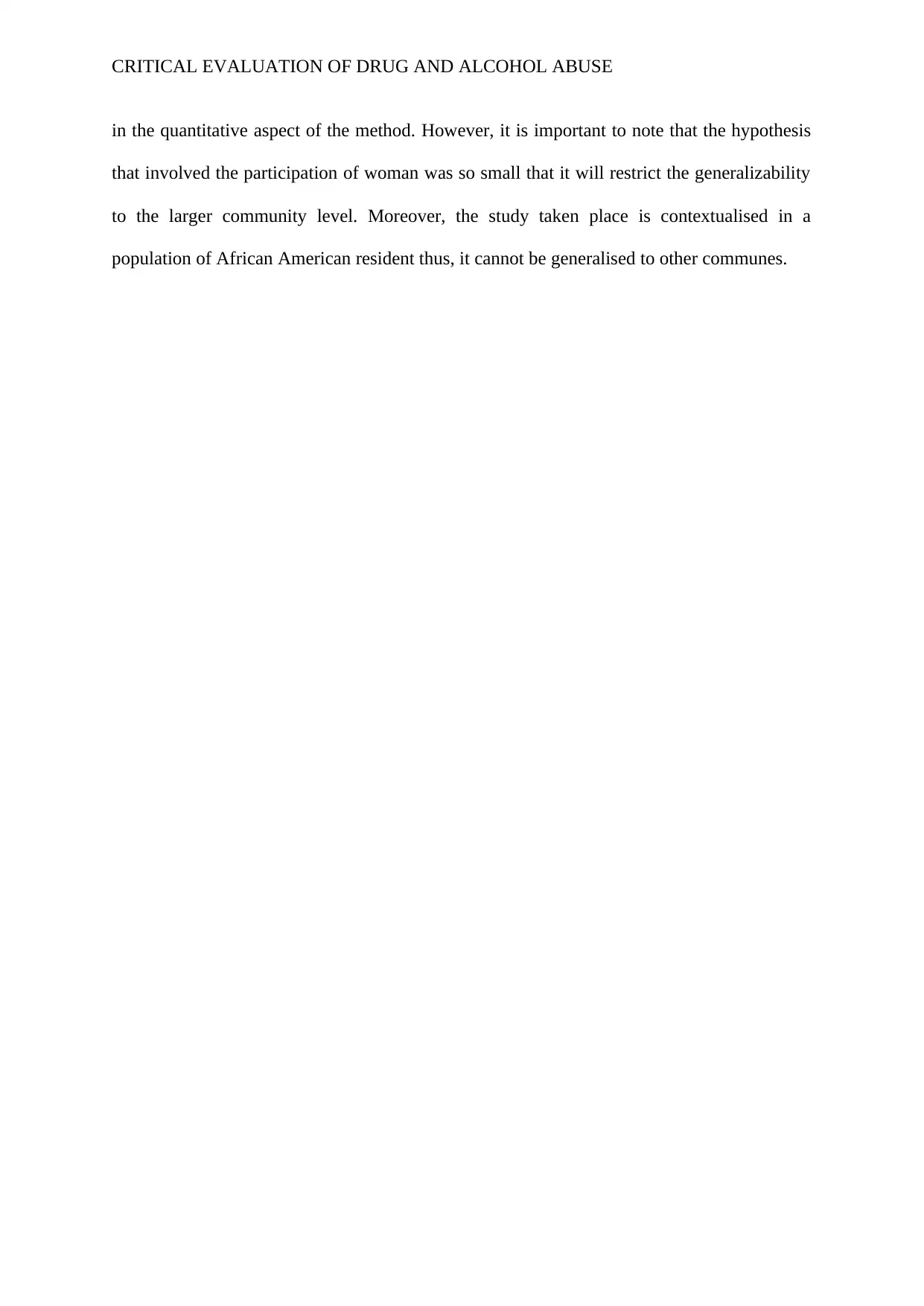
CRITICAL EVALUATION OF DRUG AND ALCOHOL ABUSE
in the quantitative aspect of the method. However, it is important to note that the hypothesis
that involved the participation of woman was so small that it will restrict the generalizability
to the larger community level. Moreover, the study taken place is contextualised in a
population of African American resident thus, it cannot be generalised to other communes.
in the quantitative aspect of the method. However, it is important to note that the hypothesis
that involved the participation of woman was so small that it will restrict the generalizability
to the larger community level. Moreover, the study taken place is contextualised in a
population of African American resident thus, it cannot be generalised to other communes.
⊘ This is a preview!⊘
Do you want full access?
Subscribe today to unlock all pages.

Trusted by 1+ million students worldwide
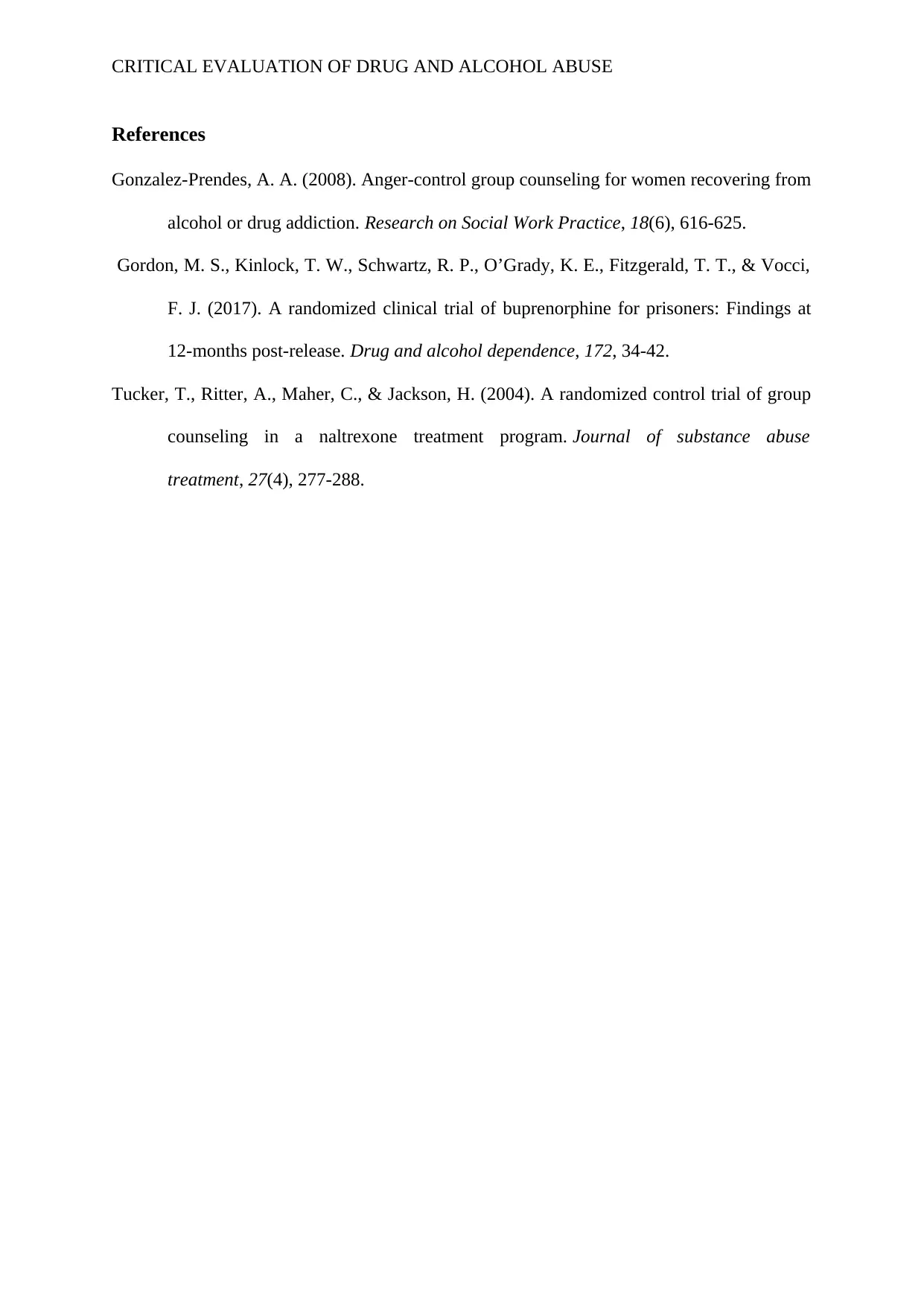
CRITICAL EVALUATION OF DRUG AND ALCOHOL ABUSE
References
Gonzalez-Prendes, A. A. (2008). Anger-control group counseling for women recovering from
alcohol or drug addiction. Research on Social Work Practice, 18(6), 616-625.
Gordon, M. S., Kinlock, T. W., Schwartz, R. P., O’Grady, K. E., Fitzgerald, T. T., & Vocci,
F. J. (2017). A randomized clinical trial of buprenorphine for prisoners: Findings at
12-months post-release. Drug and alcohol dependence, 172, 34-42.
Tucker, T., Ritter, A., Maher, C., & Jackson, H. (2004). A randomized control trial of group
counseling in a naltrexone treatment program. Journal of substance abuse
treatment, 27(4), 277-288.
References
Gonzalez-Prendes, A. A. (2008). Anger-control group counseling for women recovering from
alcohol or drug addiction. Research on Social Work Practice, 18(6), 616-625.
Gordon, M. S., Kinlock, T. W., Schwartz, R. P., O’Grady, K. E., Fitzgerald, T. T., & Vocci,
F. J. (2017). A randomized clinical trial of buprenorphine for prisoners: Findings at
12-months post-release. Drug and alcohol dependence, 172, 34-42.
Tucker, T., Ritter, A., Maher, C., & Jackson, H. (2004). A randomized control trial of group
counseling in a naltrexone treatment program. Journal of substance abuse
treatment, 27(4), 277-288.
1 out of 10
Related Documents
Your All-in-One AI-Powered Toolkit for Academic Success.
+13062052269
info@desklib.com
Available 24*7 on WhatsApp / Email
![[object Object]](/_next/static/media/star-bottom.7253800d.svg)
Unlock your academic potential
Copyright © 2020–2025 A2Z Services. All Rights Reserved. Developed and managed by ZUCOL.





